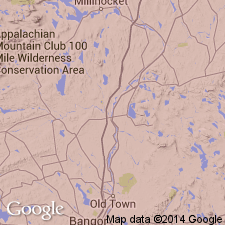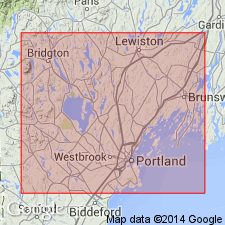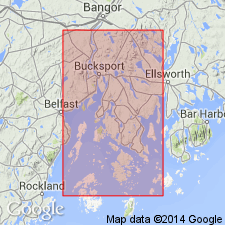
- Usage in publication:
-
- Bucksport formation
- Modifications:
-
- Named
- Dominant lithology:
-
- Quartzite
- AAPG geologic province:
-
- New England province
Summary:
Name Bucksport formation credited to J.M. Trefethen (1950: Preliminary map of Bucksport area, Maine: Maine University). Described as thin-banded limey quartzite-uniform bands of light-greenish and dark-gray to purple bands. Lighter bands are quartz rich, and original calcareous minerals have been recrystallized to form lime silicates, mostly diopside; darker bands are quartz and biotite rich, and purple tints are due to finely divided biotite. Overlies Penobscot formation; appears to be overlain and interbedded with unit referred to as Veazie formation (new). Age not stated.
Source: GNU records (USGS DDS-6; Reston GNULEX).

- Usage in publication:
-
- Bucksport Formation
- Modifications:
-
- Areal extent
- AAPG geologic province:
-
- New England province
Summary:
Bucksport Formation is here restricted from the Casco Bay area of southwestern ME, where biotite and calc-silicate granofels previously mapped as Bucksport are included within the Sebascodegan formation (informal) of the Casco Bay Group. Though the lithologies of the Sebascodegan are similar to those of the type Bucksport in east-central ME, significant differences in bedding style and the amount of calc-silicate suggest that they may not be correlatable. "If, in fact, the Sebascodegan and Bucksport do correlate, as it appears from the outcrop pattern, then the Silurian to Devonian age of the Bucksport should be questioned, as the Sebascodegan is considered late Precambrian to Ordovician."
Source: GNU records (USGS DDS-6; Reston GNULEX).

- Usage in publication:
-
- Bucksport Formation*
- Modifications:
-
- Age modified
- AAPG geologic province:
-
- New England province
Summary:
Age of Bucksport Formation of Trefethen (1950) and Wing (1957) changed to Silurian(?) based on along-strike correlation with Flume Ridge Formation. Flume Ridge dated as Silurian by West and others (1992, Silurian age for the Pocomoonshine Gabbro-Diorite, southeastern Maine and its regional tectonic implications: American Journal of Science, v. 292, p. 253-273), Ludman (1991, Revised stratigraphy of the Cookson Group in eastern Maine and southwestern New Brunswick, an alternative view: Atlantic Geology, v. 27, no. 1, p. 49-55), and Fyffe (1992, Geology of the Flume Ridge-Kedron Stream areas, Charlotte County, New Brunswick, IN Abbott, S.A., ed., Project summaries for 1991, sixteenth annual review of activities: New Brunswick Department of Natural Resources and Energy, Information Circular 91-2, p 12-20; and 1992, Revised stratigraphy of early Paleozoic rocks in the Piskahegan Stream-Mount Pleasant area of southwestern New Brunswick [abs.]: Atlantic Geology, v. 28, no. 2, p. 197-198).
Source: GNU records (USGS DDS-6; Reston GNULEX).
For more information, please contact Nancy Stamm, Geologic Names Committee Secretary.
Asterisk (*) indicates published by U.S. Geological Survey authors.
"No current usage" (†) implies that a name has been abandoned or has fallen into disuse. Former usage and, if known, replacement name given in parentheses ( ).
Slash (/) indicates name conflicts with nomenclatural guidelines (CSN, 1933; ACSN, 1961, 1970; NACSN, 1983, 2005, 2021). May be explained within brackets ([ ]).

